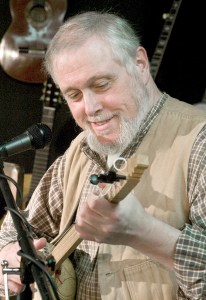LEWISTON — Robert Lloyd Webb, a historian of the banjo and a renowned performer in the clawhammer or frailing style, will present “Ring the Banjar!: The Story of America’s ‘Own’ Musical Instrument” on Thursday, Aug. 23, at Museum L-A.
The program coincides with the museum’s current exhibit, “The Power of Music, Photographic Portraits of Americans and their Musical Instruments, 1860-1915.” On display are images of soldiers and children, girls and mothers, members of both wealthy and poor families proudly showing their prized possessions — many of which are banjos.
Called “America’s ‘Own’ Musical Instrument,” the banjo has been adapted for playing every form of American popular music — minstrels, jazz, dance band, country, folk and bluegrass. A century ago, the banjo was played in the world’s great classical and operatic compositions.
Though owing its birth to African antecedents, the banjo evolved on U.S. soil, first as a rhythm accompaniment to the dances of enslaved peoples, and then through the circus and minstrel shows.
Webb will trace its rise in popularity through the Civil War and Westward expansion into urban cities and towns, where it became a parlor favorite, and then, after World War I, back onto the professional stage in dance bands and traditional jazz groups.
He will discuss how the banjo made its way into the Appalachian and Ozark mountains, where it became a distinctive part of rural entertainment, and eventually became the driving instrument in the relatively modern musical style called bluegrass.
Webb will tell how the banjo was mass-produced and sold through mail-order catalogs, beginning in the 1880s when banjo makers in Philadelphia, New York, Boston and Maine were making some of the most artistically elaborate instruments ever manufactured.
His hour-long presentation will include performances on a half-dozen instruments, including two replica gourd-bodied banjos from the late 18th century; a replica minstrel banjo as played by theater professionals in the 1840s-50s; a classical banjo of the style popular in urban parlors circa 1870-1920; a homemade fretless banjo from the hill country of North Carolina; and a modern, factory-made banjo of the familiar type.
Webb has his own history with the instrument. He developed and curated the first museum exhibition about the banjo, “Ring the Banjar!: The Banjo in America from Folklore to Factory,” for the MIT Museum in Cambridge, Mass., in 1984. The monograph from that exhibition, under the same name, has remained in print and is now available in its second edition. Webb will sign copies after the program. His CDs of traditional folk and roots music will be available.
“Ring the Banjar!: The Story of America’s ‘Own’ Musical Instrument” will begin at 7 p.m. Admission is $5 for adults, $3 for seniors and students, and free for children under 6. Museum L-A is at 35 Canal St. in the Bates Mill Complex. For more information, call 333-3881 or email [email protected].

Comments are no longer available on this story